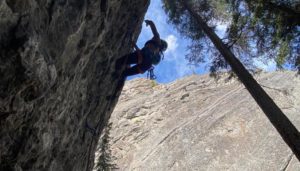Mountain Lingo Everyone Should Know

Climbers have a language of their own and there are a few basic terms which everyone should know. Here is a list of mountaineering terms for those wondering what something like glissade means.
Mountaineering Shop Talk
ACUTE MOUNTAIN SICKNESS (AMS) |
Also known as altitude sickness, a common medical condition experienced by climbers due to lack of oxygen at high altitudes. Characterized by headaches, nausea, and fatigue. Symptoms generally clear up with acclimatization. Severe cases will necessitate descending, which generally relieves symptoms. |
ALPINE START |
Starting a climb during the night or early morning hours. A common strategy that takes advantage of firm snow during the coolest part of the day and avoid afternoon storms. |
BERGSCHRUND |
Giant crevasse found at the upper limit of glacier movement, formed where the moving glacier breaks away from the ice cap or snowfield above. |
BONKING |
Caused by a lack of nutrition combined with over-exertion. A sudden feeling of lethargy that can be overcome by taking a short break and ingesting sugars and carbs. Also known as “hitting the wall.” |
CORNICE |
An overhanging edge of snow on a ridge. |
CRAMPONS |
A set of metal spikes that attach to boots in order to penetrate hard snow and ice. |
CREVASSE |
A crack in a glacier surface. Crevasses vary in width and depth and are often concealed by surface snow. They may be small enough to step over or large enough to require crossing by ladder. |
CRUX |
The most significant, committing, or difficult section of a climb. |
EXPOSURE |
A term used to describe the amount of open space below a section of climbing. Can also describe the climber’s proximity to severe weather or rock fall. |
GLISSADE |
A controlled slide on snow, using the spike of the ice-axe as a rudder and brake. There is also a standing version sometimes called boot skiing. |
ICE-AXE |
Specialized ax used by climbers. |
MORAINE |
Mounds of large boulders, rock and debris deposited by a glacier. |
PITCH |
A section of a climb punctuated by belays or rest-stops. |
PRESSURE BREATHING |
Characterized by pursing one’s lips and forcefully exhaling. The technique clears CO2 from the lungs and creates back-pressure, increasing the amount of oxygen inhaled during the next breath. |
REST STEP |
A technique used to reduce fatigue and maintain a consistently slow pace. A pause between steps allows the climber to entirely weight the straightened, downhill leg giving the bent uphill leg a moment of recovery. |
SCREE |
An accumulation of loose rock, ranging from gravel to sand, that can be tedious to ascend. |
SELF-ARREST |
Ice-ax technique used to stop a fall or slide on snow. |
SERAC |
A tower of ice on a glacier. |
SHORT-ROPE |
Roped climbing in which all members of a climb-team are connected by rope-lengths of 20 feet or less. The purpose of this technique is to stop a slip before it becomes a fall or slide. |
Check out the latest buyer's guide:
The Best Climbing Gear According to Our Editors – April
Every month we're bringing you our favourite gear so you can complete your climbing kit with the latest and best stuff out there


